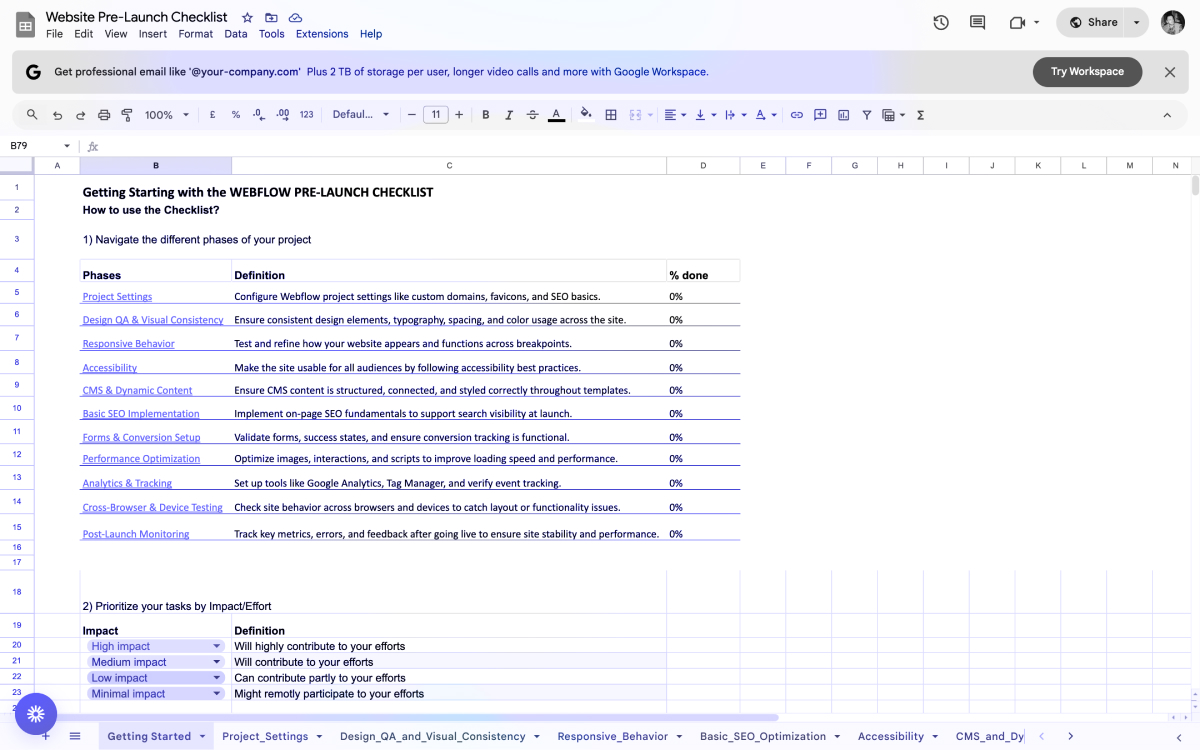Most B2B websites fail to deliver real business results.
They look great on the surface but don’t attract the right buyers, guide complex decision-making processes, or generate qualified leads. The problem? They were built without a clear B2B website strategy.
A B2B website isn’t just a digital presence—it’s your primary sales and marketing engine. And in today’s market, where 77% of B2B buyers research online before ever talking to sales, your site has to do the heavy lifting.
This guide will show you how to:
- Align your website with your business goals.
- Design for multi-stakeholder buyer journeys.
- Build conversion paths that generate measurable results.
- Stay ahead of trends like AI personalization and Answer Engine Optimization (AEO).
Whether you’re planning a redesign or building from scratch, this is the blueprint for turning your website into a growth engine.
Why a B2B Website Strategy is Essential
Too often, companies treat their website as a static asset rather than a dynamic growth driver. A clear B2B website strategy changes that by aligning design, content, and technology with business objectives.
Here’s why strategy matters:
- Your Website is Your Sales Engine: Unlike B2C, B2B websites must cater to complex buying committees and longer sales cycles. Your site needs to educate, nurture, and convert multiple stakeholders, not just attract casual visitors.
- First Impressions Matter: Studies show 90% of B2B buyers will rule out a vendor with a poor website experience. A strategic approach ensures you make a strong first impression.
- Digital-First Buyer Journeys: Today’s B2B buyers do extensive research online before ever speaking to a sales rep. A clear website strategy aligns your content and UX with these self-guided journeys.
- Lost Opportunities Without Strategy: Without clarity on goals, audience, and messaging, websites often underperform—failing to capture leads, support sales teams, or differentiate from competitors.
Core Elements of a B2B Website Strategy
An effective B2B website strategy isn’t built on design alone. It weaves together multiple disciplines to guide buyers through complex journeys. Let’s break down the key components:

Brand Positioning & Messaging
Your website is the first touchpoint for many B2B buyers, and the way you position your brand can make or break their trust. Clear, consistent messaging ensures prospects immediately understand who you are, what you offer, and why you’re the right partner.
- Define your unique value proposition and communicate it clearly across your website.
- Ensure messaging speaks to decision-makers and resonates with their pain points and goals.
- Consistency across pages builds trust and authority.
Audience & Buyer Personas
B2B sales rarely involve a single decision-maker. Understanding your audience—and mapping out the different stakeholders in the buying process—is critical to creating a website that speaks to their needs at every stage.
- Identify and segment target audiences, including industries, company sizes, and roles in the decision-making process.
- Map their journey from awareness to conversion and tailor content to each stage.
Content Strategy & SEO
Great content doesn’t just fill pages—it attracts qualified traffic, educates buyers, and moves them closer to conversion. Pairing a thoughtful content plan with strong SEO ensures your site becomes a magnet for the right visitors.
For example, when we worked with Cryptoworth, a crypto accounting platform, we overhauled their technical SEO and content structure. This boosted their site health score from 78 → 95%, eliminated 400+ critical SEO errors, optimized 10 bottom-of-funnel pages and over 300 meta assets, and helped increase organic keyword rankings from 1,200 to 1,800—all while migrating their redesigned site with zero traffic loss.
To build similar momentum, focus on these key actions:
- Develop educational and solution-focused content that aligns with search intent. Use Semrush to analyze trending topics within your niche.
- Optimize pages for relevant keywords to drive organic traffic.
- Include case studies, whitepapers, and thought leadership to establish credibility.

User Experience (UX) & Design
No matter how strong your messaging is, poor design will lose your audience in seconds. A clean, intuitive user experience keeps visitors engaged and helps guide them through complex buying journeys.
We partnered with Avarra AI, an AI-powered sales coaching platform, to redesign their website for a modern, professional feel that aligned with their brand and supported better usability. The goal was to create a seamless experience for their target buyers and position the platform as an enterprise-ready solution.
If you’re looking for expert support on crafting enterprise-ready user experiences, our B2B web design agency specializes in building high-performing websites for SaaS and tech brands.
To achieve similar results, focus on these UX and design principles:
- Prioritize clean, intuitive navigation and responsive design. For sites with extensive content, implementing a mega menu can help maintain clarity in navigation, see our Mega Menu Examples for inspiration.
- Fast load times and a mobile-first approach are critical for engagement and SEO.
- Use visuals strategically to guide visitors and emphasize key points.
Conversion Paths (CTAs)
Every page should have a purpose. Strategically placed calls-to-action (CTAs) ensure visitors always know the next step—whether it’s booking a demo, downloading a guide, or contacting sales, after which, users are sent to a thank you page.
- Place clear calls-to-action throughout the site to guide users toward demos, consultations, or downloads.
- Simplify forms and lead capture mechanisms to minimize friction.
Technology & Integrations
Modern B2B websites don’t operate in isolation. They connect seamlessly with CRM systems, marketing automation tools, and analytics platforms to deliver personalized experiences and support your sales and marketing teams.
If you’re using HubSpot as part of your stack, setting up a smooth Webflow Hubspot integration ensures leads flow directly into your CRM and trigger automated workflows—reducing manual effort and keeping your sales funnel aligned.
To build a tech stack that supports your strategy, focus on these key integration points:
- Connect your website with CRM, marketing automation tools, and analytics platforms to streamline lead management and reporting.
- Leverage personalization engines to deliver targeted content based on user behavior and buyer journeys.

Analytics & Optimization
A website strategy isn’t complete without a feedback loop. Measuring performance and making data-driven improvements ensures your site stays aligned with business goals and continues to drive results over time.
Working with conversion rate optimization experts can help you uncover hidden opportunities and implement high-impact changes faster.
To improve performance:
- Define key metrics (leads, conversion rate, bounce rate) and monitor them regularly.
- Use heatmaps and session recordings to identify areas for improvement.
- Run A/B tests to optimize headlines, layouts, and CTAs. Through our Optibase partnership, we leverage industry-leading A/B testing tools to continuously optimize our pages.
Developing and Implementing Your Strategy
Building an effective B2B website strategy isn’t just about design or content in isolation. It’s about aligning every decision with your business goals and the buyer journey. Here’s how to develop and implement a strategy that delivers measurable results.
Align with Business Goals
Every successful website starts with clarity. Defining how your site supports your overall business objectives ensures every design and content decision drives meaningful results.
- Start by identifying what role your website plays in your overall business strategy: lead generation, brand awareness, hiring, or even e-commerce.
- Map these goals to measurable KPIs (e.g., increase qualified leads by 20%, improve demo requests, or boost organic traffic).
- Align stakeholders early to avoid conflicting priorities later in the process.
Conduct Audience Research
You can’t build for buyers you don’t understand. Deep research into your audience’s roles, needs, and decision-making processes is the foundation of a site that converts.
- Develop detailed buyer personas based on interviews, surveys, and analytics.
- Understand your target companies’ decision-making processes, pain points, and preferred content types.
- Consider all stages of the B2B buyer journey, from awareness to decision, and identify what information users need at each step.
Plan Structure & Features
Your sitemap and core features should reflect user priorities and business goals—not internal assumptions. Thoughtful planning at this stage prevents costly redesigns later.
If you’re starting from scratch, our guide on how to build a business website can help you map out a clear structure and avoid common pitfalls during development.
- Create a sitemap that reflects strategic priorities, ensuring users can easily navigate to high-value pages (e.g., product, case studies, pricing).
- Decide on core functionality (interactive calculators, memberships and gated content, live chat, etc.) to support both UX and lead generation.
- Plan for scalability to accommodate new content or features as your business grows.

Design & Content Creation
With the structure in place, it’s time to bring your brand to life. Design and content work hand in hand to engage users and guide them through the buyer journey.
- Develop a design system with consistent branding, typography, and visual hierarchy.
- Craft copy that is clear, persuasive, and tailored to B2B buyers (focus on benefits over features).
- Balance evergreen content (e.g., solution pages) with timely updates (e.g., blog posts, webinars).
Build & Test
Building a high-performing B2B website isn’t just about getting the visuals right—it’s about building a solid technical foundation. Every element needs to be tested to ensure it works flawlessly across devices, browsers, and screen sizes.
Partnering with a Webflow development agency ensures your build is scalable, accessible, and optimized for speed from day one. From clean code structure to technical SEO best practices, the right team can help you avoid common pitfalls that hurt site performance.
However, not all agencies are the same, so be sure to refer to our guide on how to choose the right Webflow agency for your business so you select a partner that can truly deliver results.
Before launch:
- Develop the site in a staging environment to identify issues early.
- Test site speed, accessibility, and usability with tools like Google Lighthouse.
- Involve actual users (if possible) to uncover UX friction points before going live.
Launch & Promote
A strategic launch sets the tone for success. Announcing your new site and monitoring its performance helps you capitalize on early momentum.
Before going live, it’s worth running through a thorough checklist to ensure nothing critical slips through the cracks. Our Website Checklist teaches you what to do before and after going live and covers the essential steps for a smooth rollout.
Key launch actions to prioritize:
- Go live during a period of low traffic to mitigate risks.
- Announce the launch via email, social media, and press releases to drive initial traffic.
- Monitor analytics closely in the first weeks to catch and fix any technical or UX issues.
Continuous Improvement
Websites are never truly “done.” Ongoing optimization keeps your site aligned with user needs and business goals as both evolve over time.
If you’re using Webflow, working with a Webflow maintenance partner ensures your site stays fast, secure, and up-to-date while your team focuses on growth.
Remember: Treat launch as the beginning, not the end.
- Regularly review analytics to identify underperforming pages.
- Experiment with A/B testing on headlines, CTAs, and forms to improve conversion rates.
- Keep content fresh with blog updates, new case studies, and additional resources.
Measuring Success and Optimization
An effective B2B website strategy doesn’t end at launch—it requires ongoing measurement and refinement to stay aligned with business goals and user needs.
Key Metrics to Track
You can’t improve what you don’t measure. Tracking the right metrics ensures your website strategy stays focused on outcomes that drive business growth.
- Traffic Volume: Monitor organic, paid, and referral traffic to assess visibility.
- Lead Conversion Rate: Track how many visitors convert into leads through forms, demo requests, or downloads.
- Engagement Metrics: Analyze bounce rate, time on site, and pages per session to gauge user interest.
- Pipeline Contribution: Understand how the website supports revenue by mapping leads to sales outcomes.

Analytics Tools
Collecting data is one thing—making sense of it is another. These tools give you visibility into user behavior and help you uncover actionable insights.
- Use Google Analytics and Search Console to monitor traffic and SEO performance.
- Leverage heatmaps and session recordings (e.g., Hotjar, Crazy Egg, Microsoft Clarity) to uncover how users interact with your pages.
- Track form submissions and CTA clicks with event tracking to measure micro-conversions.
Benchmarking and Insights
Numbers alone don’t tell the full story. Benchmarking your performance against competitors and industry standards helps you spot strengths and gaps worth addressing.
- Compare your website performance to industry benchmarks to identify gaps and opportunities.
- Set up dashboards for at-a-glance views of KPIs, ensuring all stakeholders stay informed.
A/B Testing and Feedback Loops
Even small tweaks can have a big impact. Continuous testing and real-world feedback let you refine your site over time and stay ahead of shifting buyer expectations.
- Regularly test variations of headlines, CTAs, and page layouts to turn your site into a high-converting website.
- Gather qualitative feedback through user surveys or interviews to uncover pain points not visible in analytics.
- Implement changes iteratively and measure their impact to avoid disrupting what’s already working.
A culture of continuous optimization helps your website evolve alongside your business and your buyers’ expectations.
Emerging Trends and Best Practices
B2B websites are evolving rapidly to meet the demands of modern buyers. Staying ahead means adopting emerging trends while adhering to proven best practices. For inspiration, you can explore our roundup of the 17 best B2B websites to see how leading companies put these principles into action.
Personalization and AI
Modern B2B buyers expect tailored experiences. Leveraging AI and personalization transforms static websites into dynamic platforms that engage visitors on their terms.
- Dynamic Content: Use AI-powered tools to tailor messaging, CTAs, and resources based on visitor behavior or industry.
- Account-Based Marketing (ABM): Serve personalized experiences for high-value target accounts.
- Chatbots and Virtual Assistants: Implement AI chat solutions to guide visitors and qualify leads in real time.
Mobile-First and Performance Optimization
Speed and mobile usability aren’t optional anymore—they’re dealbreakers. While most B2B traffic visits B2B sites on desktop during working hours, and mobile tends to drive minimal conversions in the B2B segment, mobile performance remains a critical signal for search engines. A sluggish or poorly optimized mobile site can hurt rankings and brand credibility.
The takeaway? Optimize for mobile not just for conversions but to support SEO and provide a seamless experience for buyers who may research on mobile even if they convert later on desktop.
- Mobile Responsiveness: Over 60% of global traffic is mobile—your site must look and perform flawlessly on all devices, even if your primary conversions happen elsewhere.
- Page Speed: Optimize images, use modern frameworks, and implement CDNs to improve load times and SEO rankings.
Data-Driven Automation
Automation bridges the gap between your website and your sales funnel. By syncing data across systems, you can nurture leads effectively and deliver a seamless buyer journey.
For Webflow sites, setting up a Zapier integration can automate tasks like sending form submissions to your CRM or triggering personalized email sequences.
- CRM Integration: Sync your website with CRM systems to enable lead nurturing and personalized email follow-ups.
- Marketing Automation: Trigger workflows based on website behavior (e.g., abandoned forms, repeat visits).

Security and Compliance
Trust is everything in B2B—especially when you’re dealing with enterprise buyers in industries where data security and regulatory compliance are non-negotiable. A secure, compliant website reassures prospects that you take their data (and their partnership) seriously.
At Tilipman Digital, we use Webflow as our tool of choice for developing client sites because of its robust security features and enterprise-grade infrastructure. If you’re wondering whether Webflow can support the security needs of your organization, we’ve explored it in detail in our guide: Is Webflow secure?
Here’s how to strengthen trust on your site:
- Ensure robust security: HTTPS, SOC 2 compliance, and GDPR alignment are essential for modern B2B sites.
- Display trust badges and certifications prominently to reassure decision-makers in sensitive industries.

Continuous Adaptation
A great website isn’t built once; it evolves. Staying proactive with audits and improvements keeps your strategy aligned with shifting buyer behaviors and technologies.
- The B2B digital landscape shifts quickly—schedule regular audits to evaluate your strategy against evolving technologies and buyer expectations.
- Monitor competitors and industry leaders to identify trends worth adopting.
By embracing innovation and committing to excellence, your B2B website can become a growth engine that drives measurable business impact.
Common Mistakes to Avoid
Even with the best intentions, B2B websites often fall short due to avoidable missteps. Knowing these pitfalls can help you sidestep them and keep your strategy on track.
Ignoring Mobile Users
- Many B2B buyers research on mobile before engaging with sales teams.
- A site that isn’t optimized for mobile can frustrate users and harm your credibility.
Feature Overload
- Adding too many interactive elements or complex navigation can overwhelm visitors.
- Focus on simplicity and clarity—prioritize the features that support buyer decisions.
Weak Messaging
- Vague or generic messaging fails to resonate with your target audience.
- Ensure your value proposition is clear, specific, and differentiated from competitors.
Neglecting Feedback Loops
- Without gathering user feedback or consulting your sales team, your site can become outdated and misaligned with buyer needs.
- Regularly review insights from analytics, heatmaps, and customer interviews to stay relevant.
Underestimating Scalability
- Failing to plan for growth (new products, global expansion) can lead to costly redesigns later.
- Build a scalable structure and use modular design systems from the start.
Treating Launch as the Finish Line
- A website is never truly “done.” Without ongoing optimization and fresh content, even great sites can lose momentum over time.
By avoiding these common mistakes, you ensure your B2B website remains a powerful tool for engaging prospects and driving business growth.
Conclusion: Turn Your B2B Website Into a Growth Engine
Your website is more than a digital brochure—it’s a powerful sales and marketing tool that can drive measurable results when built on a solid strategy. From clear messaging and buyer-focused UX to continuous optimization, every decision should align with your business goals and audience needs.
A well-executed B2B website strategy doesn’t just attract visitors—it nurtures them through complex buying journeys and converts them into long-term customers.
FAQs: B2B Website Strategy
What is a B2B website strategy?
A B2B website strategy is a comprehensive plan for designing, building, and optimizing a website to support business goals. It focuses on attracting qualified leads, educating complex buyer groups, and converting them into customers through a mix of design, content, and technology decisions.
How is a B2B website different from a B2C website?
B2B websites cater to longer sales cycles, multiple decision-makers, and often require more in-depth content (like case studies and whitepapers). In contrast, B2C websites are usually designed for individual consumers and emphasize quick purchases with simpler user journeys.
What are the key elements of an effective B2B website?
An effective B2B website includes:
- Clear brand positioning and messaging
- Buyer-focused UX and design
- SEO-optimized content for every stage of the buyer journey
- Strong CTAs and lead capture mechanisms
- Integration with CRM and marketing automation tools
How often should I update my B2B website strategy?
At minimum, review your strategy annually to ensure it aligns with evolving buyer behavior, market trends, and business objectives. However, continuous monitoring and incremental improvements are ideal for staying competitive.
Do I need a marketing agency to develop a B2B website strategy?
While some businesses handle this in-house, a specialized agency can bring expertise, tools, and proven frameworks to build a strategy faster and with better long-term results. Some businesses do prefer to bring in a freelancer. We wrote an article to give you a better understanding if you need a freelancer or a Webflow agency.







